My urge to get “growing” is strong as we get closer to spring (in just over four weeks!!). I confess, I’ve dabbled in the dirt already – having sown a few flats of basil, thyme, parsley, and chives in mid-January. But the serious work of starting more than 1,000 heirloom tomato and vegetable seedlings is about to begin.
I love starting vegetable plants from seed. Each tiny seed holds a promise…of a beautiful heirloom tomato, a bushel of beans, or maybe the “great” pumpkin. I never tire of seeing those first shoots of green emerge from the soil.
Starting vegetables from seed is easy and requires little equipment – not to mention it’s fun and very rewarding! This is the first of a two-part article on growing vegetables from seed, covering the why, how to choose, and when to start sowing. So let’s get growing…
Why Seeds?
Purchased transplants definitely have a place in the garden. Some vegetables just aren’t easy to grow from seed and often available time (and timing) is a factor. However, when compared to transplants, growing from seed offers several great benefits:
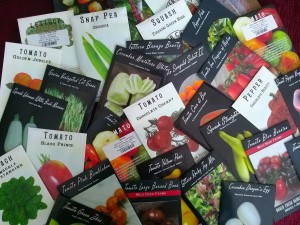 More Choices: Open any seed catalog and you’ll find hundreds of vegetable seed choices – from artichokes to zucchini – with several cultivars of each. By contrast, garden centers are often limited in the types of vegetables and cultivars offered. Growing from seed is a low-risk way to try something new – like purple beans or white tomatoes!
More Choices: Open any seed catalog and you’ll find hundreds of vegetable seed choices – from artichokes to zucchini – with several cultivars of each. By contrast, garden centers are often limited in the types of vegetables and cultivars offered. Growing from seed is a low-risk way to try something new – like purple beans or white tomatoes!
Money Saver: A packet of seed is relatively inexpensive when compared to purchasing plant starts. Most packets contain more seed than you will use in a season – providing your garden with ample plants and seeds to share with friends or save for next year. When stored properly, many vegetable seeds last from 2 to 6 years.
More Control: Transplants may come with an iffy provenance. When you start vegetables from seed, you’re in control over your growing environment – from the seed stock you choose (organic, heirloom, open-pollinated, or hybrid) to the soils and fertilizers that are used. At harvest you’ll know exactly what went in to each vegetable you grew.
How to Choose What to Grow
With such a large selection of vegetable seeds available, how do you choose what’s best for your garden? First, know your growing season and select varieties that will mature within that season.
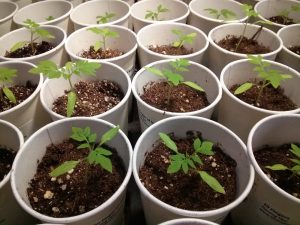
Choose varieties that mature within 90 days. These Sasha Altai heirloom tomatoes are ready for harvest in about 70 days.
For shorter-season climates like northern Idaho, choose varieties that mature (are ready for harvest) within 90 days. If you shop for seed from regional companies (such as Snake River Seed Co-Op or Adaptive Seeds), you’ll be able to purchase seed stock that is adapted to our climate, as well as finding various “early producing” cultivars. Just look for the “days to maturity” to be 90 days or less on the seed packet.
While you can grow cultivars with a longer days to maturity (over 90 days), you will most likely need to employ some season-extending tactics to achieve a harvest.
When to Plant
Timing is everything when growing from seed. Whether direct sowing in the garden or starting seeds indoors, it’s critical to know the last average day of frost for your region. For northern Idaho that date is May 15th – keep in mind, it’s only an average date.
Direct Sowing
Prepare your vegetable beds early in the spring by lightly digging in well-rotted manure and/or compost as soon as the soil is workable. Workable soil is moist and crumbly – if soil clumps into a ball when squeezed, or worse yet, water runs out – it’s too wet. Let it dry a bit, otherwise you’ll create rock-like clumps of soil that will be nearly impossible to break down (words from this gardener’s experience!).
Most cool season vegetables, like peas, carrots, and lettuces, can be direct sown into the garden two to four weeks before the last average frost (mid-April through mid-May for northern Idaho).
Warm season crops, like beans, cucumbers, and squash, are extremely frost intolerant, in fact, these plants will perish in cool, wet conditions. Direct sow these crops well after all danger of frost has past – usually mid-May through early June. Warm season crops require full sun, along with nighttime temperatures AND soil temperatures of at least 55 degrees.
2 to 4 weeks before frost direct sow: Lettuce, peas, radishes, carrots, beets, potatoes, and onions.
2 to 3 weeks after frost direct sow: Basil, corn, cucumbers, pumpkins, and squash.
3 to 4 weeks after frost direct sow: All varieties of beans.
Since late spring weather can be unpredictable, it’s good idea to have some protection readily available for tender, young seedlings. These include fabric row covers, cloches, or gallon jugs to place over seedlings.
Starting Seeds Indoors
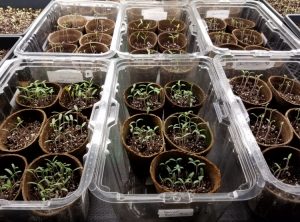
Tomato seedlings started in peat pots inside plastic produce containers. Tomatoes should be started 6 to 8 weeks before the last frost.
Vegetable seeds can be started indoors from 3 weeks to 8 weeks prior to the last average frost date, depending on the variety. Most warm season crops, like tomatoes, peppers, and eggplant are usually started between 6 and 8 weeks before this date.
Vining crops, such as cucumbers, pumpkin, and squash can be started in late April to be transplanted in late May when the soil and air temperatures are warm.
Cool season crops, like brassicas (cabbage, broccoli, and cauliflower), lettuces, and peas, can all be started indoors about 4 to 6 weeks before the last frost. These vegetables are cold hardy, and can often be transplanted into the garden before the last average frost date.
8 weeks before frost start indoors: Broccoli, cabbage, eggplant, lettuce, peppers.
6 weeks before frost start indoors: Basil, tomatoes, tomatillos.
3 to 4 weeks before frost start indoors: Cucumbers, pumpkins, squash.
Why Not Start Seeds Indoors Now?
You may be thinking, why not just start everything now and have large plants to put in the ground in spring? In theory this idea sounds good, but in practice it isn’t; here’s why: starting seeds too soon can result in leggy, weak plant stock.
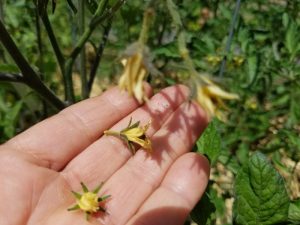
Blossom drop occurs when pollination is incomplete. This is often due to temperatures being too cool or too hot.
Seedlings will soon outgrow their containers and become root bound and stressed. In addition, many vegetables require warm temperatures to pollinate – larger plants that are flowering in cooler temperatures are at risk for blossom drop due to incomplete pollination.
It’s been proven that younger (and smaller) plant stock grows just as quickly as larger/leggy transplants. If anything, it’s better to start a little later than earlier!
Hardening Off
Both cool and warm season seedlings started indoors need to slowly be acclimated to the outdoor environment before planting. This transitional step is known as hardening off. If plants aren’t properly hardened off, they can quickly perish in the garden.
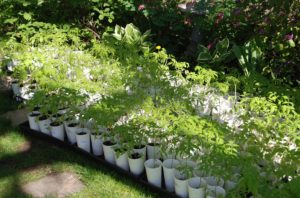
Seedling should be gradually introduced to the outdoor environment. To avoid sunburn, begin in partial shade.
Begin the hardening off process 7 to 10 days before planting out. Weather plays an important role—daytime temperatures should be a minimum of 55°F, with little wind and no rain. Start by placing plants in a protected shaded area for 20 to 30 minutes.
Gradually increase the amount of time the plants are outside each day. Young plants are extremely susceptible to sunburn, so avoid direct sunlight for the first few days. As plants adapt, move them to filtered sunlight. Reducing water, along with cooler temperatures, will gradually harden the tender plant stem.
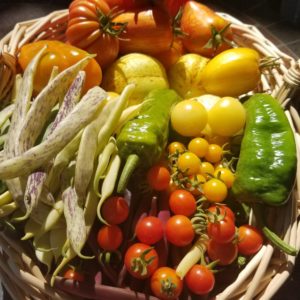 The satisfaction you get from planting one tiny seed and watching it grow, blossom, and bear fruit that you harvest and eat is truly one of the greatest pleasure of gardening!
The satisfaction you get from planting one tiny seed and watching it grow, blossom, and bear fruit that you harvest and eat is truly one of the greatest pleasure of gardening!
Up Next: Growing Vegetables from Seed: Part 2. A step-by-step how-to guide for successfully starting seeds indoors.
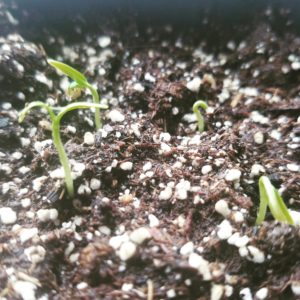
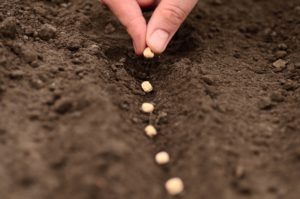


Thank you for all you’re a help. I enjoyed my gardening for well over 20 years now. I live in Boise Idaho and good reminders of 68 weeks before planting season. I usually start my seat lanes inside. But curiosity serves me that. Do I not need to keep my growing room? At least 50% degrees are higher.